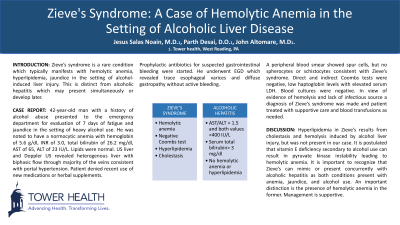Back


Poster Session A - Sunday Afternoon
Category: Liver
A0559 - Zieve's Syndrome: A Case of Hemolytic Anemia in the Setting of Alcoholic Liver Disease
Sunday, October 23, 2022
5:00 PM – 7:00 PM ET
Location: Crown Ballroom

Has Audio

Jesus Salas Noain, MD
Tower Health - Reading Hospital
Reading, PA
Presenting Author(s)
Jesus Salas Noain, MD1, Parth Desai, DO1, Shefali Amin, DO, MSEd2, Andrew E. Lee, MD3, Oluwaseun Shogbesan, MD2, John Altomare, MD4
1Tower Health - Reading Hospital, Reading, PA; 2Reading Tower Health, Reading, PA; 3Tower Health, Reading, PA; 4Reading Hospital Tower Health, West Reading, PA
Introduction: Zieve’s syndrome is a rare condition which typically manifests with hemolytic anemia, hyperlipidemia, jaundice in the setting of alcohol-induced liver injury. This is distinct from alcoholic hepatitis which may present simultaneously or develop later.
Case Description/Methods: 42-year-old man with a history of alcohol abuse and compensated cirrhosis presented to the emergency department for evaluation of 7 days of fatigue and jaundice in the setting of heavy alcohol use. He was noted to have a normocytic anemia with hemoglobin of 5.6 g/dl, INR of 3.0, total bilirubin of 26.2 mg/dl, AST of 65, and ALT of 23 IU/L. Lipid profile was normal. US liver and Doppler US revealed heterogenous liver with biphasic flow through majority of the veins consistent with portal hypertension. Patient denied recent use of new medications or herbal supplements. Prophylactic antibiotics for suspected gastrointestinal bleeding were started. He underwent EGD which revealed trace esophageal varices and portal hypertensive gastropathy without active bleeding. A peripheral blood smear showed spur cells, but no spherocytes or schistocytes consistent with Zieve's syndrome. Direct and indirect Coombs tests were negative, low haptoglobin levels, and elevated serum LDH. Blood cultures were all negative. In view of evidence of hemolysis and lack of infectious source a diagnosis of Zieve’s syndrome was made and patient treated with supportive care and blood transfusions as needed. Unfortunately, the patient was placed in comfort measures after developing refractory grade IV hepatic encephalopathy and hepato-renal syndrome despite supportive measures.
Discussion: Hyperlipidemia in Zieve’s syndrome results from cholestasis and hemolysis induced by alcohol liver injury, but was not present in our case. It is postulated that vitamin E deficiency secondary to alcohol use can result in pyruvate kinase instability which affects RBC metabolism resulting in hemolytic anemia. It is important to recognize that Zieve’s can mimic or present concurrently with alcoholic hepatitis as both conditions present with anemia, jaundice, and alcohol use. An important distinction is the presence of hemolytic anemia in the former. Management is supportive as well as abstinence from alcohol.
Disclosures:
Jesus Salas Noain, MD1, Parth Desai, DO1, Shefali Amin, DO, MSEd2, Andrew E. Lee, MD3, Oluwaseun Shogbesan, MD2, John Altomare, MD4. A0559 - Zieve's Syndrome: A Case of Hemolytic Anemia in the Setting of Alcoholic Liver Disease, ACG 2022 Annual Scientific Meeting Abstracts. Charlotte, NC: American College of Gastroenterology.
1Tower Health - Reading Hospital, Reading, PA; 2Reading Tower Health, Reading, PA; 3Tower Health, Reading, PA; 4Reading Hospital Tower Health, West Reading, PA
Introduction: Zieve’s syndrome is a rare condition which typically manifests with hemolytic anemia, hyperlipidemia, jaundice in the setting of alcohol-induced liver injury. This is distinct from alcoholic hepatitis which may present simultaneously or develop later.
Case Description/Methods: 42-year-old man with a history of alcohol abuse and compensated cirrhosis presented to the emergency department for evaluation of 7 days of fatigue and jaundice in the setting of heavy alcohol use. He was noted to have a normocytic anemia with hemoglobin of 5.6 g/dl, INR of 3.0, total bilirubin of 26.2 mg/dl, AST of 65, and ALT of 23 IU/L. Lipid profile was normal. US liver and Doppler US revealed heterogenous liver with biphasic flow through majority of the veins consistent with portal hypertension. Patient denied recent use of new medications or herbal supplements. Prophylactic antibiotics for suspected gastrointestinal bleeding were started. He underwent EGD which revealed trace esophageal varices and portal hypertensive gastropathy without active bleeding. A peripheral blood smear showed spur cells, but no spherocytes or schistocytes consistent with Zieve's syndrome. Direct and indirect Coombs tests were negative, low haptoglobin levels, and elevated serum LDH. Blood cultures were all negative. In view of evidence of hemolysis and lack of infectious source a diagnosis of Zieve’s syndrome was made and patient treated with supportive care and blood transfusions as needed. Unfortunately, the patient was placed in comfort measures after developing refractory grade IV hepatic encephalopathy and hepato-renal syndrome despite supportive measures.
Discussion: Hyperlipidemia in Zieve’s syndrome results from cholestasis and hemolysis induced by alcohol liver injury, but was not present in our case. It is postulated that vitamin E deficiency secondary to alcohol use can result in pyruvate kinase instability which affects RBC metabolism resulting in hemolytic anemia. It is important to recognize that Zieve’s can mimic or present concurrently with alcoholic hepatitis as both conditions present with anemia, jaundice, and alcohol use. An important distinction is the presence of hemolytic anemia in the former. Management is supportive as well as abstinence from alcohol.
Disclosures:
Jesus Salas Noain indicated no relevant financial relationships.
Parth Desai indicated no relevant financial relationships.
Shefali Amin indicated no relevant financial relationships.
Andrew Lee indicated no relevant financial relationships.
Oluwaseun Shogbesan indicated no relevant financial relationships.
John Altomare indicated no relevant financial relationships.
Jesus Salas Noain, MD1, Parth Desai, DO1, Shefali Amin, DO, MSEd2, Andrew E. Lee, MD3, Oluwaseun Shogbesan, MD2, John Altomare, MD4. A0559 - Zieve's Syndrome: A Case of Hemolytic Anemia in the Setting of Alcoholic Liver Disease, ACG 2022 Annual Scientific Meeting Abstracts. Charlotte, NC: American College of Gastroenterology.
